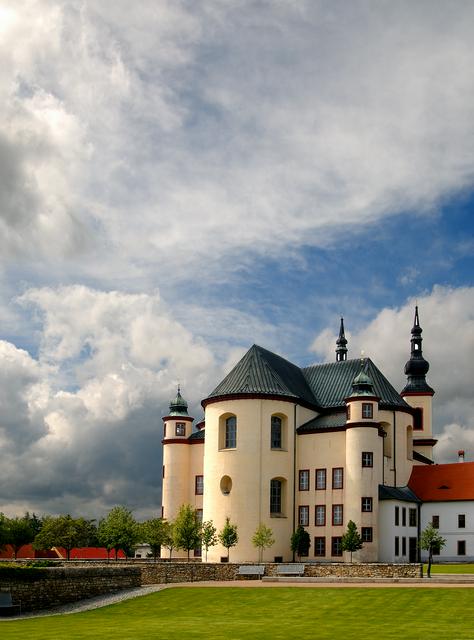
Litomyšl (German: Leitomischl) is a small city (10,000 inhabitants) in Eastern Bohemia. Its renaissance chateau is one of the twelve Czech sites inscribed on the UNESCO World Heritage List, and the town is famous as the birthplace of composer Bedřich Smetana.
The first historical mention of Litomyšl dates back to 981, when there was a castle protecting an important trade route between Bohemia and Moravia. Under the protection of the castle, a settlement began to rise.
In the 12th century the order of Premonstrates came to Litomyšl. Due to their colonization and cultural efforts, the settlement's importance rose dramatically and it was promoted to the city level in 1259. Medieval Litomyšl was the third most important Czech city (after Prague and Olomouc), becoming a seat of a bishop in 1344 by decree of Roman Emperor Charles IV. However, as a Catholic stronghold, it was burned down by the Hussite rebellion and the bishopric has never been restored.
Later during the industrial revolution, the council decided that it did not want the main railroad (from Prague to Olomouc) going through the city. That is why Litomyšl remained a relatively small, quiet town with an almost untouched historical centre, making it the true jewel of Eastern Bohemia.
- Litomyšl Castle. Is an outstanding and immaculately preserved example of the arcade castle, a type of building first developed in Italy and modified in the Czech lands to create an evolved form of special architectural quality. The main external feature of the castle is the sgraffito decoration: what look from a distance like bricks are in fact designs made from etching away plaster to reveal the undercoat. Each design is different and the centres contain many different images, from leaves to people. A highlight of the interior is the preserved baroque theatrette, which is one of only five left in the world. The castle was the birth place of composer Bedřich Smetana, and the rooms in which he spent the first years of his life are open to the public.
- The Castle’s wine vaults house a display by the sculptor Olbram Zoubek, who after being banned by the communist government spent 20 years restoring the sgraffiti decorations on the castle. It is quite cold and eerie but you get a look at odd parts of the castle, a blanket and free mulled wine! More Zoubek sculptures are installed in the nearby monastery gardens and on one of the houses on the main square.
- The Portmoneum. Is a small museum dedicated to printmaker, painter and poet Josef Váchal. In the early 20th century Váchal was commissioned to paint the interior of the house belonging to his friend and publisher Josef Portman, and it’s this building that houses the museum. Visitors walk through several rooms in which every square inch has been covered with intensely coloured and expressionistic murals of nightmarish scenes. Even some of the furniture was painted and carved by Váchal.
- The main square of Litomyšl is one of the prettiest in the country, and is almost surrounded by arcade fronted pastel painted houses from the renaissance period. The tower half way along belongs to the old town hall and features an ornate clock face and a plaque commemorating the use of a special medieval measurement known as a Czech Elbow.
Litomyšl Castle. Is an outstanding and immaculately preserved example of the arcade castle, a type of building first developed in Italy and modified in the Czech lands to create an evolved form of special architectural quality. The main external feature of the castle is the sgraffito decoration: what look from a distance like bricks are in fact designs made from etching away plaster to reveal the undercoat. Each design is different and the centres contain many different images, from leaves to people. A highlight of the interior is the preserved baroque theatrette, which is one of only five left in the world. The castle was the birth place of composer Bedřich Smetana, and the rooms in which he spent the first years of his life are open to the public.
The Castle’s wine vaults house a display by the sculptor Olbram Zoubek, who after being banned by the communist government spent 20 years restoring the sgraffiti decorations on the castle. It is quite cold and eerie but you get a look at odd parts of the castle, a blanket and free mulled wine! More Zoubek sculptures are installed in the nearby monastery gardens and on one of the houses on the main square.
The Portmoneum. Is a small museum dedicated to printmaker, painter and poet Josef Váchal. In the early 20th century Váchal was commissioned to paint the interior of the house belonging to his friend and publisher Josef Portman, and it’s this building that houses the museum. Visitors walk through several rooms in which every square inch has been covered with intensely coloured and expressionistic murals of nightmarish scenes. Even some of the furniture was painted and carved by Váchal.
The main square of Litomyšl is one of the prettiest in the country, and is almost surrounded by arcade fronted pastel painted houses from the renaissance period. The tower half way along belongs to the old town hall and features an ornate clock face and a plaque commemorating the use of a special medieval measurement known as a Czech Elbow.
There are plenty of places around town selling local wines.
The bar at the station serves beer for a remarkable 10,50Kč (about €0,36 - there won't be many places cheaper than this anywhere.)
You have to get out the way you came in through the highway.
